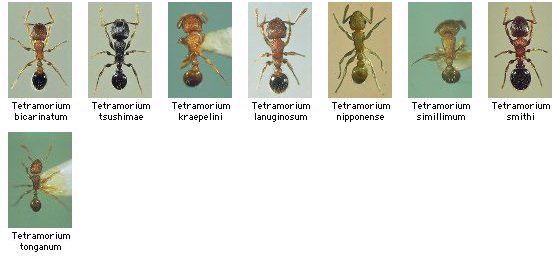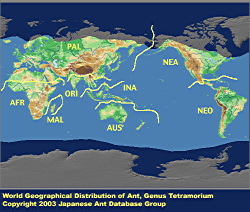
|
genus
|
Tetramorium
|
 |

|
|
Japanese Name
|
Shiwa-ari-zoku
|
Original Reference
|
|
Mayr, G. (1855) Formicina austriaca. Beschreibung der bisher im sterreichischen Kaiserstaate aufgefundenen Ameisen nebst Hinzufgung jener in Deutschland, in der Schweiz und in Italien vorkommenden Ameisen. Verhandlungen des Zoologisch-Botanischen Vereins in Wien 5: 273-478.
|
Description
|
|
Total length of workers around 2 - 4 mm. Eyes more or less developed, situated almost in the middle of sides of head. Mandibles with several teeth; the apical three distinct. Palpal formula 4:3 in Japanese species. Clypeus in front of each antennal insertion forming a ridge. Antennae 11- or 12-segmented; apical three segments forming a club. Frontal carinae variable, usually well-developed. Promesonotum depressed. Metanotal groove sometimes obscure on the dorsal surface of mesosoma. Propodeal spines variously developed, ranging from small-dentiform to elongate-spiniform. Lower portion of propodeum sometimes with spiniform lamellae. Petiolar node generally distinct and with a more or less flat dorsal surface. Terminal portion of sting with a small triangular lamelliform appendage.
|
|

|
Remarks
|
|
Males of Tetramorium are distinctive in having 11-segmented antennae, of which the 3rd segment is characteristically elongate. The genus comprises about 250 species, distributed mainly in the Afrotropical and Oriental regions. Taxonomic revisions of the tribe Tetramoriinae including Tetramorium have been presented by Bolton (1976, 1977, 1979, 1980, 1985). Ten species have been recorded from Japan. Among them the record of T. amium is doubtful, and the difference between T. kraepelini and T. tanakai is obscure. We thus currently recognize 8 Japanese species.
|
References
|
|
- Bolton, B. (1976). The ant tribe Tetramoriini (Hymenoptera: Formicidae). Constituent genera, review of smller genera and revision of Triglypothrix Forel. . Bull. Br. Mus. Nat. Hist. (Ent.), 34, 281-378.
- Bolton, B. (1977). The ant tribe Tetramoriini (Hymenoptera: Formicidae). The genus Tetramorium Mayr in the Oriental and Indo-Australian regions, and in Australa. . Bull. Br. Mus. Nat. Hist. (Ent.), 36, 67-151.
- Bolton, B. (1979). The ant tribe Tetramoriini (Hymenoptera: Formicidae). The genus Tetramorium Mayr in the Malagasy region and in the New World. . Bull. Br. Mus. Nat. Hist. (Ent.), 38, 129-181.
- Bolton, B. (1980). The ant tribe Tetramoriini (Hymenoptera: Formicidae). The genus Tetramorium Mayr in the Ethiopian zoogeographical region. . Bull. Br. Mus. Nat. Hist. (Ent.), 40, 193-384.
- Bolton, B. (1985). The ant genus Triglyphothrix Forel a synonym of Tetramorium Mayr. (Hymenoptera: Formicidae). J. Nat. Hist., 19, 243-248.
|
Editor
|
|
Original text by Kazuo Ogata and Keiichi Onoyama. English translation by Kazuo Ogata, edited by Robert W. Taylor.
|
|